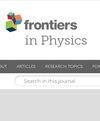Fe2Cu2 聚合物支链中的量子磁性:从精确求解的 Ising-Heisenberg 模型中获得的启示
IF 1.9
3区 物理与天体物理
Q2 PHYSICS, MULTIDISCIPLINARY
引用次数: 0
摘要
自旋-1/2 Ising-Heisenberg 支链的灵感来自三种等结构高分子配位化合物[(Tp)2Fe2(CN)6X (bdmap)Cu2(H2O)]⋅H2O 的磁性结构,进一步表示为 Fe2Cu2(Tp = 三(吡唑基)硼酸酯,bdmapH = 1,3-双(二甲基氨基)-2-丙醇,HX = 乙酸、丙酸或三氟乙酸)、bdmapH = 1,3-双(二甲基氨基)-2-丙醇,HX = 乙酸、丙酸或三氟乙酸),采用转移矩阵法进行了严格研究。整个基态相图显示了三个不同的阶段:量子反铁磁相、量子铁磁相和经典铁磁相。在零温磁化曲线中,两个量子基态分别表现为饱和磁化率为零和一半的中间高原,而在经典铁磁相中,磁化率达到饱和值。与量子反铁磁相相比,量子铁磁相中近邻海森堡自旋之间的双向纠缠更为明显,这是因为伊辛自旋具有完全极化的性质。自旋-1/2 Ising-Heisenberg 支链的理论预测与磁感应强度的温度依赖性和低温磁化曲线的实验数据之间的合理一致性表明,在高分子化合物 Fe2Cu2 中,近邻 Cu2+-Cu2+ 磁性离子之间具有很强的反铁磁耦合,而近邻 Cu2+-Fe3+ 磁性离子之间具有中等强度的铁磁耦合。近邻 Cu2+-Cu2+ 磁离子之间的热纠缠一直持续到相对较高的阈值温度 T≈ 224 K,并经历了瞬态磁场驱动的强化。本文章由计算机程序翻译,如有差异,请以英文原文为准。
Quantum magnetism in Fe2Cu2 polymeric branched chains: insights from exactly solved Ising-Heisenberg model
The spin-1/2 Ising-Heisenberg branched chain, inspired by the magnetic structure of three isostructural polymeric coordination compounds [(Tp)2 Fe2 (CN)6 X (bdmap)Cu2 (H2 O)] ⋅ H2 O to be further denoted as Fe2 Cu2 (Tp = tris(pyrazolyl)hydroborate, bdmapH = 1,3-bis(dimethylamino)-2-propanol, HX = acetic acid, propionic acid or trifluoroacetic acid), is rigorously studied using the transfer-matrix method. The overall ground-state phase diagram reveals three distinct phases: a quantum antiferromagnetic phase, a quantum ferrimagnetic phase and a classical ferromagnetic phase. In the zero-temperature magnetization curve, two quantum ground states are manifested as intermediate plateaus at zero and half of the saturation magnetization, while the magnetization reaches its saturated value within the classical ferromagnetic phase. The bipartite entanglement between nearest-neighbor Heisenberg spins is more pronounced in the quantum ferrimagnetic phase compared to the quantum antiferromagnetic phase due to a fully polarized nature of the Ising spins. A reasonable agreement between theoretical predictions for the spin-1/2 Ising-Heisenberg branched chain and experimental data measured for a temperature dependence of the magnetic susceptibility and a low-temperature magnetization curve suggests strong antiferromagnetic coupling between nearest-neighbor Cu2+ -Cu2+ magnetic ions and moderately strong ferromagnetic coupling between nearest-neighbor Cu2+ -Fe3+ magnetic ions in the polymeric compounds Fe2 Cu2 . A thermal entanglement between nearest-neighbor Cu2+ -Cu2+ magnetic ions persists up to a relatively high threshold temperature T ≈ 224 K and undergoes a transient magnetic-field-driven strengthening.
求助全文
通过发布文献求助,成功后即可免费获取论文全文。
去求助
来源期刊

Frontiers in Physics
Mathematics-Mathematical Physics
CiteScore
4.50
自引率
6.50%
发文量
1215
审稿时长
12 weeks
期刊介绍:
Frontiers in Physics publishes rigorously peer-reviewed research across the entire field, from experimental, to computational and theoretical physics. This multidisciplinary open-access journal is at the forefront of disseminating and communicating scientific knowledge and impactful discoveries to researchers, academics, engineers and the public worldwide.
 求助内容:
求助内容: 应助结果提醒方式:
应助结果提醒方式:


